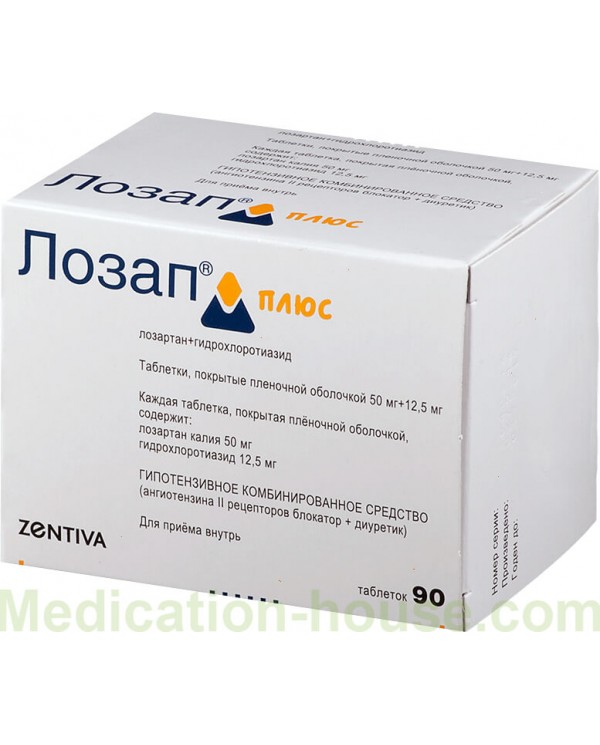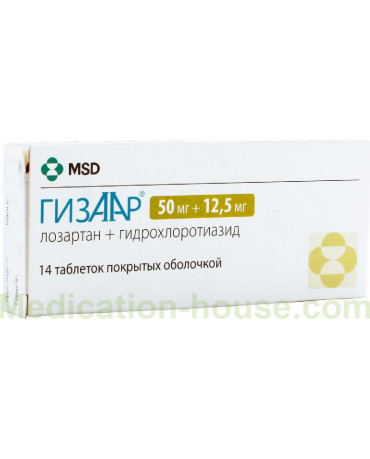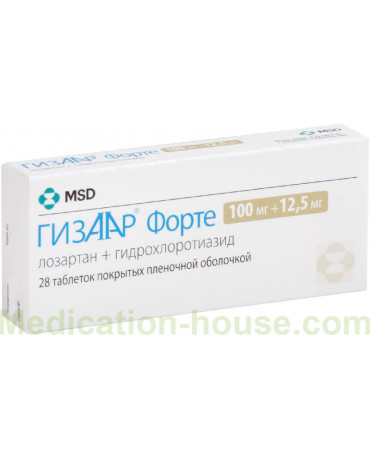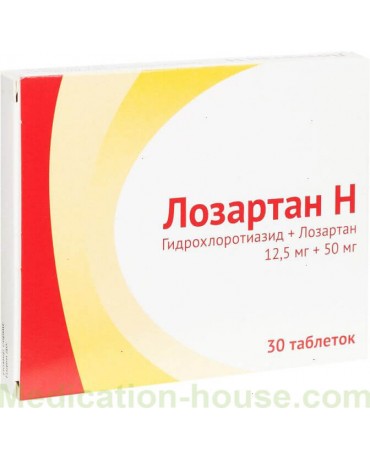Lozap Plus instruction
You can buy Lozap Plus here
Lozap Plus is a combined antihypertensive drug containing an angiotensin II receptor antagonist (AT1 receptor blocker) and a diuretic.
Release form and composition
Lozap Plus is produced in the form of film-coated tablets: oblong, on both sides with dividing lines, light yellow (10 pcs. In blisters, in a cardboard box of 3, 6 or 9 blisters; 15 pcs. In blisters, in cardboard box 2, 4 or 6 blisters).
Composition for 1 tablet:
active ingredients: losartan potassium - 50 mg; hydrochlorothiazide - 12.5 mg;
auxiliary ingredients: microcrystalline cellulose, mannitol, croscarmellose sodium, magnesium stearate, povidone;
film casing: hypromellose 2910/5, talc, macrogol 6000, simethicone emulsion, Crimson dye [Ponso 4R] (E124), Quinoline yellow dye (E104).
Pharmacodynamics
Losartan is a specific angiotensin II receptor antagonist (AT1 subtype) that inactivates bradykinin and does not suppress the enzyme kinase II. Reduces OPSS (total peripheral vascular resistance), the concentration of aldosterone and adrenaline in the blood, blood pressure (blood pressure), pressure in the vessels of the pulmonary circulation; reduces afterload, has a diuretic effect. Prevents the appearance of myocardial hypertrophy, improves exercise tolerance in patients with CHF (chronic heart failure).
Hydrochlorothiazide - a thiazide diuretic inhibits the reabsorption of sodium ions, increases the excretion of bicarbonate, potassium ions and phosphates in the urine. Reduces blood pressure by reducing the BCC (circulating blood volume), suppressing the pressor effect of vasoconstrictor substances, changing the reactivity of the vascular wall and increasing the inhibitory effect on the ganglia.
Pharmacokinetics
absorption: after oral administration, losartan and hydrochlorothiazide are rapidly absorbed from the gastrointestinal tract (gastrointestinal tract); the bioavailability of losartan is ~ 33%, the time to reach the Cmax (maximum concentration) of losartan is 1 hour, and its active metabolite is 3-4 hours;
distribution: losartan binds to blood plasma proteins in 99%;
metabolism: losartan undergoes presystemic elimination (the so-called effect of the first passage through the liver), is metabolized in the liver by carboxylation, forms an active metabolite; hydrochlorothiazide is not metabolized by the liver;
Excretion: T ½ (half-life) of losartan is 1.5–2 hours, and its main metabolite is 3-4 hours; ~ 35% of the dose is excreted in the urine, ~ 60% in the feces; for hydrochlorothiazide T1 / 2 - 5.8-14.8 hours; ~ 61% is excreted unchanged in the urine.
Indications for use
Lozap Plus is recommended to be used as part of the complex therapy of arterial hypertension in patients for whom this form of treatment is optimal. The drug is also taken for arterial hypertension and left ventricular hypertrophy in order to reduce the risk of developing cardiovascular pathologies and mortality.
Contraindications
Absolute:
hypokalemia / hypercalcemia, resistant to therapy;
severe liver failure;
refractory hyponatremia;
obturation of the biliary tract;
anuria;
hyperuricemia / gout;
severe renal failure with CC (creatinine clearance) ≤ 30 ml / min;
period of pregnancy;
lactation (breastfeeding);
children and adolescents up to 18 years old;
increased individual sensitivity to sulfonamide derivatives, active and auxiliary ingredients of the drug.
Relative contraindications (Lozap Plus is taken with caution): bilateral stenosis of the renal arteries or stenosis of an artery of a single kidney, hyponatremia (high risk of arterial hypotension in patients on a low or salt-free diet), hypovolemic states (including vomiting, diarrhea ), hypomagnesemia, hypochloremic alkalosis, connective tissue diseases (including systemic lupus erythematosus), liver dysfunction or progressive liver disease, bronchial asthma (including a history), diabetes mellitus, aggravated allergic history, simultaneous taking NSAIDs (non-steroidal anti-inflammatory drugs) and cyclooxygenase (COX) -2 inhibitors, belonging to the Negroid race.
Instructions for use Lozap Plus: method and dosage
Lozap Plus tablets are taken orally, regardless of meal time.
Recommended dosage regimen according to indications:
arterial hypertension: starting and maintenance dose - 1 tablet per day, in the absence of adequate blood pressure control, the dose can be increased to the maximum - 2 tablets once a day; the maximum hypotensive effect of the drug is achieved within 3 weeks from the start of therapy;
reducing the risk of developing cardiovascular pathologies and mortality in patients with arterial hypertension and left ventricular hypertrophy: starting dose of losartan - 50 mg / day; in the absence of adequate control and the target blood pressure level against the background of losartan monotherapy, a combination of losartan with hydrochlorothiazide in a low dose (12.5 mg) is required, which is provided by the drug Lozap Plus; if necessary, the dose can be increased to 2 tablets once a day (100 mg of losartan + 25 mg of hydrochlorothiazide).
Side effects
The scale of the distribution of adverse reactions by the frequency of development: very often ≥ 0.1; often ≥ 0.01 but <0.1; infrequently ≥ 0.001 but <0.01; rarely ≥ 0.0001 but <0.001; very rare <0.0001, with unknown frequency - from the available data, the frequency cannot be calculated.
In clinical studies of the combination of losartan-hydrochlorothiazide, additional side effects associated with their joint use were not recorded. All side effects due to taking Lozap Plus were limited to those previously observed when using losartan or hydrochlorothiazide alone.
In controlled clinical trials of losartan and hydrochlorothiazide therapy for essential hypertension, the only side effect that manifested itself with a frequency of ≥ 1% compared with placebo was dizziness. Other adverse reactions reported as a result of the use of a combination of losartan / hydrochlorothiazide in the treatment of essential hypertension:
liver and biliary tract: rarely - hepatitis;
laboratory and instrumental studies: rarely - an increase in the activity of hepatic transaminases, hyperglycemia.
The use of losartan / hydrochlorothiazide can cause side effects characteristic of each of the components separately.
Losartan
blood and lymphatic system: infrequently - anemia, ecchymosis, Shenlein-Henoch disease (hemorrhagic vasculitis), hemolysis;
immune system: rarely - anaphylactic reactions, urticaria, angioedema (lips, face, pharynx, larynx, tongue);
metabolism and nutrition: infrequently - gout, anorexia;
psyche: often - insomnia; infrequently - anxiety, anxiety, panic attacks, depression, confusion, drowsiness, sleep disturbances, unusual dreams, memory impairment;
nervous system: often - dizziness, headache; infrequently - paresthesia, increased excitability, peripheral neuropathy, migraine, tremor, fainting;
organ of vision: infrequently - blurred vision, decreased visual acuity, burning sensation in the eye, conjunctivitis;
organ of hearing and labyrinthine disorders: infrequently - ringing in the ears, vertigo;
heart: infrequently - orthostatic hypotension, arterial hypotension, angina pectoris, pain in the sternum, atrioventricular (AV) blockade of the II degree, myocardial infarction, cerebrovascular disorders, arrhythmias (sinus bradycardia, atrial fibrillation, tachycardia, ventricular fibrillation, cardiac tachycardia) ;
vessels: infrequently - vasculitis;
respiratory system: often - upper respiratory tract infections, cough, nasal congestion, sinusitis; infrequently - laryngitis, pharyngitis, dyspnea, nosebleeds, bronchitis, rhinitis;
Gastrointestinal tract: often - nausea, diarrhea, abdominal pain, dyspepsia; infrequently - vomiting, constipation, dry mouth, gastritis, flatulence, toothache;
liver and bile ducts: with unknown frequency - liver dysfunction;
skin and subcutaneous tissues: infrequently - itching, rash, dermatitis, alopecia, dry skin, erythema, hyperemia, photosensitivity, hyperhidrosis;
musculoskeletal system and connective tissue: often - muscle cramps, leg pain, back pain, sciatica; infrequently - muscle and bone pain, joint swelling, joint stiffness, arthritis, arthralgia, muscle weakness, fibromyalgia; with an unknown frequency - rhabdomyolysis;
kidneys and urinary tract: infrequently - urge to urinate, nocturia, urinary tract infections;
reproductive system: infrequently - decreased libido / potency;
the body as a whole: often - fatigue, asthenia, chest pain; infrequently - fever, swelling of the face;
laboratory and instrumental studies: often - a slight decrease in hematocrit and hemoglobin, hyperglycemia; infrequently - a slight increase in the level of urea and creatinine; very rarely - an increase in the level of bilirubin and liver enzymes.
Hydrochlorothiazide
hematopoietic system: infrequently - aplastic anemia, agranulocytosis, hemolytic anemia, purpura, leukopenia, thrombocytopenia;
immune system: rarely - anaphylactic reactions up to anaphylactic shock;
metabolism: infrequently - hyperglycemia, hyperuricemia, hypomagnesemia, hyponatremia, hypokalemia, hypochloremic alkalosis, hypercalcemia, anorexia;
psyche: infrequently - insomnia;
nervous system: infrequently - headache;
organ of vision: infrequently - xanthopsia, temporary decrease in visual acuity;
vessels: infrequently - cutaneous or necrotizing vasculitis;
respiratory system: infrequently - RDS (respiratory distress syndrome), including noncardiogenic pulmonary edema and pneumonitis;
Gastrointestinal tract: infrequently - gastritis, nausea / vomiting, diarrhea, spasms, constipation, sialadenitis;
liver and biliary tract: infrequently - cholecystitis, cholestatic jaundice, pancreatitis;
skin and subcutaneous tissues: infrequently - urticaria, photosensitivity, toxic epidermal necrolysis;
musculoskeletal system and connective tissue: infrequently - muscle cramps;
kidneys and urinary tract: infrequently - interstitial nephritis, glycosuria, renal failure, renal dysfunction;
the body as a whole: infrequently - dizziness, fever.
Overdose
There is no information on the specific therapy of Lozap Plus overdose. It is recommended to stop taking the drug and monitor the patient's condition. Symptomatic therapy is shown, including gastric lavage (if the tablets have been taken recently), elimination of electrolyte disturbances, dehydration and lowering blood pressure by standard methods - restoring BCC and water-electrolyte balance.
Overdose typical for each of the components separately:
losartan: the most frequently reported symptoms of overdose are tachycardia and a marked decrease in blood pressure; bradycardia can be caused by stimulation of the parasympathetic nervous system. With symptomatic arterial hypotension, maintenance infusion therapy is recommended. Losartan, like its active metabolite, is not excreted by hemodialysis;
hydrochlorothiazide: the most frequently reported symptoms of overdose are the result of electrolyte deficiency (hypochloremia, hypokalemia, hyponatremia) and dehydration due to excessive diuresis. Simultaneous reception of cardiac glycosides with hypokalemia can aggravate the course of arrhythmias. There is no specific antidote, the degree of elimination of hydrochlorothiazide by hemodialysis is unknown.
Special instructions
Losartan
Patients with a history of angioedema (swelling of the lips, face, pharynx, and / or tongue) should be treated under close supervision.
In patients with hypovolemia and / or low sodium content, due to restriction of salt intake with food, intensive use of diuretics or diarrhea / vomiting, symptomatic arterial hypotension may develop (especially after the first dose). Correction of such conditions is required before starting therapy with Lozap Plus.
Violations of the water-electrolyte balance often occur in renal failure, therefore, careful monitoring of the content of potassium in the blood plasma and CC indices is necessary, especially in patients with heart failure with CC 30-50 ml / min. The combined use of Lozap Plus with potassium preparations, potassium-sparing diuretics and salt substitutes containing potassium is not recommended.
There is no experience of using the drug in patients who have recently undergone kidney transplantation.
In primary hyperaldosteronism, there is usually no response to therapy with antihypertensive drugs that inhibit the renin-angiotensin system, so the use of Lozap Plus is not recommended.
Excessive lowering of blood pressure in patients with cerebrovascular disease or coronary artery disease, as with any other antihypertensive drugs, can cause myocardial infarction or stroke.
With heart failure, with or without renal impairment, there is an increased risk of severe arterial hypotension and renal dysfunction, often acute, as with the use of other drugs that affect the RAAS (renin-angiotensin system).
Special care is required in the treatment of patients with obstructive hypertrophic cardiomyopathy or aortic / mitral stenosis, as with the use of other vasodilators.
Losartan, similar to other ACE (angiotensin converting enzyme) inhibitors, and angiotensin antagonists, are less effective in lowering blood pressure in representatives of the Negroid race in comparison with representatives of other races. Perhaps this is due to more frequent episodes of low renin levels in representatives of this race in the population with arterial hypertension.
Hydrochlorothiazide
Hydrochlorothiazide, like any other antihypertensive drugs, can potentiate symptomatic arterial hypotension in some patients. Therefore, it is necessary to control the appearance of such clinical signs of a violation of the water-electrolyte balance as hyponatremia, hypovolemia, hypochloremic alkalosis, hypokalemia or hypomagnesemia, which can form against the background of concomitant vomiting or diarrhea. In such patients, the level of electrolytes in the blood serum should be checked periodically (after a certain time). In the presence of edema in hot weather, the development of hypervolemic hyponatremia is possible.
Thiazide diuretic therapy can lead to impaired glucose tolerance, as a result of which it may be necessary to adjust the dose of antidiabetic agents, including insulin. Taking thiazides by patients with impaired glucose tolerance is fraught with the manifestation of diabetes mellitus.
Thiazide diuretics can inhibit urinary calcium excretion and potentiate a periodically insignificant increase in serum calcium levels. Severe hypercalcemia may be a sign of latent hyperparathyroidism. With the upcoming study of the function of the parathyroid glands, hydrochlorothiazide should be discontinued prior to diagnosis.
The use of thiazide diuretics may result in an increase in blood triglyceride and cholesterol levels.
Due to the use of thiazide diuretics, some patients may develop hyperuricemia and / or gout. Since losartan lowers uric acid levels, its use in combination with hydrochlorothiazide may slow down the development of diuretic-induced hyperuricemia.
During therapy with thiazides, patients with a history of hypersensitivity and / or bronchial asthma may develop allergic reactions; described cases of occurrence or exacerbation of SLE (systemic lupus erythematosus). Allergic reactions can also be caused by the Crimson [Ponso 4R] dye in the tablets.
Influence on the ability to drive vehicles and complex mechanisms
The impact of Lozap Plus on the ability to perform types of work requiring a high speed of psychomotor reactions and increased concentration of attention has not been studied. But, given such side effects of antihypertensive drug therapy, such as dizziness or drowsiness, you should drive vehicles or work with complex mechanisms with caution, especially during the initiation of treatment or when the dose of the drug is increased.
Application during pregnancy and lactation
The effect of the active ingredients of Lozap Plus on pregnancy:
hydrochlorothiazide: experience with its use, especially in the first trimester, is limited, and there are insufficient data from animal studies. It is known that hydrochlorothiazide penetrates the placental barrier and is found in the blood of the umbilical cord. Given the pharmacological mechanism of action of the substance, it can be assumed that when used by pregnant women, fetoplacental blood flow may deteriorate and cause such pathologies in the fetus / newborn as jaundice, thrombocytopenia and electrolyte imbalance;
losartan: it is known that angiotensin II receptor antagonists, when used in the II and III trimesters of pregnancy, have a fetotoxic effect, expressed by a decrease in renal function, oligohydramnios, delayed ossification of the skull, and also show toxicity to the newborn, causing renal failure, arterial hypotension and hyperkalemia.
When using Lozap Plus, pregnant women in the II and III trimesters are recommended to carry out an ultrasound (ultrasound) examination of the fetal skull and kidneys.
Newborns whose mothers took Lozap Plus during pregnancy need careful monitoring for the development of arterial hypotension.
When planning a pregnancy, it is required to switch to alternative antihypertensive treatment options with an established safety profile. If pregnancy is diagnosed during Lozap Plus therapy, the drug should be interrupted immediately and an alternative treatment should be chosen.
Lozap Plus tablets are contraindicated during pregnancy!
There is no data on the use of Lozap Plus during lactation. It is known that hydrochlorothiazide passes into breast milk, and thiazide diuretics can cause intense diuresis and can inhibit milk production. In this connection, when breastfeeding, the use of the drug is contraindicated.
Childhood use
Since the safety and efficacy of the drug in children and adolescents under 18 years of age have not been studied, Lozap Plus is contraindicated in this age group of patients.
With impaired renal function
Losartan, like other substances that affect the RAAS, can increase serum urea and creatinine levels in patients with bilateral renal artery stenosis or renal artery stenosis of a solitary kidney. There is evidence of impaired renal function as a result of inhibition of the RAAS, for example, with pre-existing renal failure or with severe heart failure. Changes in renal function may be reversible and decrease after drug withdrawal.
According to the instructions, Lozap Plus is recommended to be taken with caution in case of bilateral renal artery stenosis or renal artery stenosis of a single kidney.
The use of Lozap Plus in severe renal impairment with CC ≤ 30 ml / min is contraindicated.
For violations of liver function
According to pharmacokinetic studies in patients with liver cirrhosis, there is a pronounced increase in plasma concentrations of losartan. Thiazide diuretics, including hydrochlorothiazide, can cause intrahepatic cholestasis, and minor disturbances in water and electrolyte balance can trigger the development of hepatic coma. In this connection, Lozap Plus is prescribed with caution in case of liver dysfunction (including a history) or with progressive liver disease. In severe liver dysfunction, the use of the drug is contraindicated.
Use in the elderly
Elderly patients do not need to adjust the dosage regimen.
Drug interactions
Losartan
rifampicin, fluconazole: cases of a decrease in the concentration of the active metabolite of losartan have been described without evaluating clinical data;
potassium-sparing diuretics (spironolactone, triamterene, amiloride), potassium preparations or salt substitutes containing potassium: may increase serum potassium levels; the combined use of these drugs is not recommended;
lithium salts: losartan can slow down the excretion of lithium, therefore, careful monitoring of their level in the blood serum is necessary;
non-steroidal anti-inflammatory drugs (NSAIDs), such as selective COX-2 inhibitors; acetylsalicylic acid in doses used for anti-inflammatory action; non-selective NSAIDs: can weaken the antihypertensive effect of Lozap Plus; the risk of deterioration in renal function increases, including acute renal failure; an increase in the level of potassium in the blood serum is possible, especially with initial impairment of renal function. The combined use is prescribed with caution, especially in old age, with the obligatory provision of patients with adequate hydration and under the control of renal function at the beginning of joint use and periodically during therapy; impaired renal function is usually reversible;
antipsychotic drugs, amifostine, baclofen, tricyclic antidepressants, other drugs that cause hypotension: the risk of arterial hypotension increases.
Hydrochlorothiazide
barbiturates, alcohol, opioid analgesics, antidepressants: the risk of orthostatic hypotension increases;
antidiabetic drugs (insulin and hypoglycemic agents for oral administration): hydrochlorothiazide can affect their glucose tolerance, which may require dose adjustment;
metformin: lactic acidosis may develop as a result of functional renal failure due to the use of hydrochlorothiazide; caution should be exercised when used together;
other antihypertensive drugs: synergism of action contributes to the development of an additive effect;
colestyramine, colestipol: ion exchange resins inhibit the absorption of hydrochlorothiazide; a single dose of colestyramine / colestipol leads to the binding of hydrochlorothiazide and reduces its absorption from the gastrointestinal tract by 85% / 43%;
corticosteroids, adrenocorticotropic hormone (ACTH): may exacerbate electrolyte deficiencies, especially hypokalemia;
pressor amines (adrenaline): a decrease in action is likely, which does not exclude their use;
non-depolarizing muscle relaxants (tubocurarine chloride): hydrochlorothiazide may enhance their effect;
lithium preparations: diuretics, including hydrochlorothiazide, reduce their renal clearance, significantly increasing the risk of toxic effects of lithium; simultaneous use is recommended to be avoided;
anti-gout drugs (sulfinpyrazone, probenecid, allopurinol): dosage adjustment may be required, since hydrochlorothiazide can increase serum uric acid levels; an increase in the manifestation of allergic reactions to allopurinol is likely;
anticholinergic drugs (atropine, biperidine): can increase the bioavailability of hydrochlorothiazide by inhibiting gastrointestinal motility and reducing the rate of gastric emptying;
cytotoxins (methotrexate, cyclophosphamide): it is possible to inhibit their excretion through the kidneys and increase the myelosuppressive effect;
salicylates: when used in high doses, their toxic effect on the central nervous system (CNS) may increase;
methyldopa: isolated episodes of hemolytic anemia have been described;
cyclosporine: increased risk of hyperuricemia and complications of gout;
cardiac glycosides: hydrochlorothiazide-induced hypokalemia / hypomagnesemia may contribute to the development of digitalis-induced arrhythmias;
digitalis glycosides, antiarrhythmics (the therapeutic effect of which depends on serum potassium levels), class IA antiarrhythmics (hydroquinidine, quinidine, disopyramide), class III antiarrhythmics (amiodarone, dofetilide, ibutilide, sotalol), some antipsychotics (chlorodepromazine, levomomoridazine, levomomoridazine , trifluoperazine, cyamemazine, sultopride, sulpiride, amisulpride, pimozide, tiapride, droperidol, haloperidol), other drugs that can cause ventricular tachycardia such as pirouette (difemanil, bepridil, cisapride, erythromycin, intravenous intravenous, pirudinamycin, terrythromycin, intravenous pirudinamycin, pentamycinamycin) : It is recommended to regularly monitor serum potassium levels, since hypokalemia is a factor predisposing to the development of pirouette tachycardia; monitoring of the electrocardiogram (ECG) is also necessary;
calcium salts: hydrochlorothiazide can increase serum calcium levels by reducing its excretion; control of serum calcium levels and appropriate adjustment of the dosage regimen of calcium preparations are required; due to the effect on calcium metabolism, hydrochlorothiazide can distort the results of tests for assessing the function of the parathyroid glands;
carbamazepine: clinical observation and laboratory monitoring of sodium levels in the blood are necessary in patients using carbamazepine, due to the risk of symptomatic hyponatremia;
iodine-containing contrast agents: with dehydration caused by diuretics, the risk of developing acute renal failure increases, especially when taking iodine preparations in high doses, therefore, rehydration is required before their introduction;
amphotericin B (parenteral), glucocorticosteroids, ACTH, stimulating laxatives, or glycyrrhizin (found in licorice): hydrochlorothiazide can cause electrolyte deficiencies, especially hypokalemia.
Terms and conditions of storage
Store in a dry place at a temperature not exceeding 30 ° C. Keep out of the reach of children.
Shelf life is 3 years.
Reviews about Lozap Plus
Patients who have chosen Lozap Plus to lower their pressure, the reviews about it are mostly positive. They write that taking pills once a day significantly improves health, steadily reduces blood pressure, and stops dizziness. Some are worried about the diuretic effect of the drug and are interested in whether it is harmful with prolonged use.
Patients with a tendency to edema are forced to abandon Lozap Plus therapy, since diuretics are contraindicated when taking it, or alternate its intake with courses of other antihypertensive drugs.
Terms of sell
A prescription from a doctor is not required to buy Lozap Plus.







